Caryn’s Thoughts
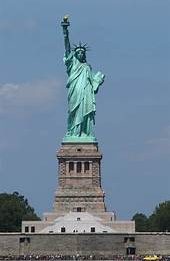 I have been to and inside the Statue of Liberty, and it is a place I’ll never forget. I was a teenager at the time, but I can still vividly picture the inside, as well as the outside. I think the thing that most stuck in my head is that to go up into the statue was a rather tight corridor. The arm was closed when we were there, but we didn’t really know why. For a time, especially after 9-11, no one was allowed to go into the Statue of Liberty at all, for fear of another terrorist attack.
I have been to and inside the Statue of Liberty, and it is a place I’ll never forget. I was a teenager at the time, but I can still vividly picture the inside, as well as the outside. I think the thing that most stuck in my head is that to go up into the statue was a rather tight corridor. The arm was closed when we were there, but we didn’t really know why. For a time, especially after 9-11, no one was allowed to go into the Statue of Liberty at all, for fear of another terrorist attack.
Prior to the 9-11 concerns, the Statue of Liberty was examined by French and American engineers for structural stability in 1982, as part of the planning for its centennial in 1986. Following the examination, it was announced that the statue was in need of considerable restoration. Careful examination had revealed that the right arm  had been improperly attached to the main structure. It was swaying more and more when strong winds blew and there was a significant risk of structural failure. This is information that I’m thankful I didn’t have when I went up into the statue in 1973. I recall being disappointed that we couldn’t go up in the arm then, but apparently they knew of the issues even then. Of further concern, the head had been installed 2 feet off center, and one of the rays was wearing a hole in the right arm when the statue moved in the wind. All the problems warranted the repairs done in 1984. She also got a nose job and her arm was shifted slightly to a better position. This information, though not well know, was really bad news, when you think about it. The statue had been standing in this place for 96 years by the time these flaws were discovered. Imagine what could have happened, especially with the arm improperly
had been improperly attached to the main structure. It was swaying more and more when strong winds blew and there was a significant risk of structural failure. This is information that I’m thankful I didn’t have when I went up into the statue in 1973. I recall being disappointed that we couldn’t go up in the arm then, but apparently they knew of the issues even then. Of further concern, the head had been installed 2 feet off center, and one of the rays was wearing a hole in the right arm when the statue moved in the wind. All the problems warranted the repairs done in 1984. She also got a nose job and her arm was shifted slightly to a better position. This information, though not well know, was really bad news, when you think about it. The statue had been standing in this place for 96 years by the time these flaws were discovered. Imagine what could have happened, especially with the arm improperly 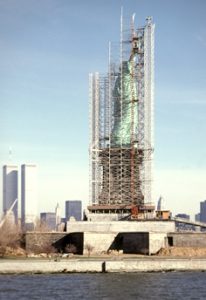 installed. The armature structure was badly corroded, and about two percent of the exterior plates needed to be replaced. Although problems with the armature had been recognized as early as 1936, when cast iron replacements for some of the bars had been installed, much of the corrosion had been hidden by layers of paint applied over the years. The whole statue was literally a ticking time bomb. Following the repairs, the statue would be much safer and could again be used, but that was not the end of her secrets.
installed. The armature structure was badly corroded, and about two percent of the exterior plates needed to be replaced. Although problems with the armature had been recognized as early as 1936, when cast iron replacements for some of the bars had been installed, much of the corrosion had been hidden by layers of paint applied over the years. The whole statue was literally a ticking time bomb. Following the repairs, the statue would be much safer and could again be used, but that was not the end of her secrets.
Most people think that the Statue of Liberty was a gift from the nation of France, and while it did come from France, it was actually partly a gift from the manufacturer in France (not the French nation). on top of that, Americans had to pay for the pedestal and partly contributed to the cost of the statue itself. Fundraisers were held in Boston and Philadelphia, in order to win the right to have the statue, but in the end, it went to New York. I’m sure many people who helped with the fundraising were very disappointed. This was another secret of the Statue of Liberty that I did not know.
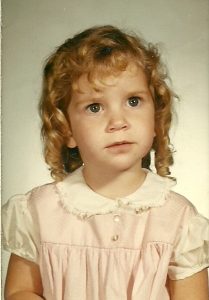
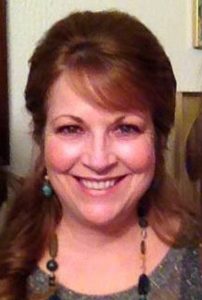 My youngest sister, Allyn Hadlock has always been a woman with a sweet, loving spirit. Many times, the youngest child is the most spoiled, but while Allyn received the least amount of discipline, it was not because she was spoiled. Our mom, Collene Spencer told us once that the reason Allyn got less spankings was because her spirit was just so grieved by a simple tongue lashing, even a couple of disciplinary words…that mom didn’t have the heart to spank her much. If Mom told her something as simple as “that was naughty,” Allyn was heartbroken. She felt so awful…about so small a transgression. Oh, to have that kind of a gentle spirit…that kind of a heart for God and doing what is right.
My youngest sister, Allyn Hadlock has always been a woman with a sweet, loving spirit. Many times, the youngest child is the most spoiled, but while Allyn received the least amount of discipline, it was not because she was spoiled. Our mom, Collene Spencer told us once that the reason Allyn got less spankings was because her spirit was just so grieved by a simple tongue lashing, even a couple of disciplinary words…that mom didn’t have the heart to spank her much. If Mom told her something as simple as “that was naughty,” Allyn was heartbroken. She felt so awful…about so small a transgression. Oh, to have that kind of a gentle spirit…that kind of a heart for God and doing what is right.
That spirit has never left Allyn. She is such a giver. She wants to do anything she can to help the people around her…whether she knows them, whether they are family, or not. She gives of her time, as well as her abilities. There is a softness in Allyn’s spirit that I just love. That little girl, who had such a soft heart, who always wanted to do what was right, the one that my sisters and I always said was always good, hasn’t changed one bit. She still does whatever she can to make life easier for those around her. She is a helper, as I’m sure those she works with will attest. She doesn’t quit until the job is done. Allyn has worked in medical administration for years now, and while her company name has changed, she has been at the same place for a long time. Today, she works for Wyoming Medical Center. She is well liked there, and well respected by her co-workers and subordinates alike. Her position is in supervision in the billing department, and she enjoys it very much. She likes the people she works with, and they all work well together.
As much as Allyn loves her job, her first love, after God that is, will always be her family. She is wife to Chris, mom to Jessi Sawdon, Ryan Hadlock, Lindsay Moore, and Kellie Hadlock. She is a beloved mother-in-law to 
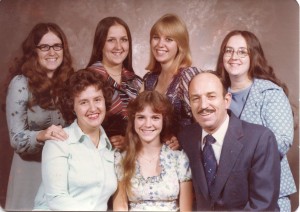 Jason Sawdon, Chelsea Hadlock, and Shannon Moore. She is also grandma to Ethan Hadlock, Aurora Hadlock, Adelaide Sawdon, and Mackenzie Moore, as well as Jonathan Sawdon and Hallie Moore who both live in Heaven. Allyn’s family is the most important thing on this earth to her. She loves each and every one with all her heart…and they love her. Today is Allyn’s birthday. Happy birthday Allyn!! Have a great day!! We love you!!
Jason Sawdon, Chelsea Hadlock, and Shannon Moore. She is also grandma to Ethan Hadlock, Aurora Hadlock, Adelaide Sawdon, and Mackenzie Moore, as well as Jonathan Sawdon and Hallie Moore who both live in Heaven. Allyn’s family is the most important thing on this earth to her. She loves each and every one with all her heart…and they love her. Today is Allyn’s birthday. Happy birthday Allyn!! Have a great day!! We love you!!

 My nephew, Jake Harmon has grown into such an incredible husband, dad, and above all, an incredible man of God. As his great aunt, I have known Jake all his life. Like most kids, there were good times and bad times. The teenaged years are tough on most kids…and their parents, but like Jake, most kids get through those tough years and move on with their adult lives. That doesn’t always mean, however, that they become something great. Many kids go on to live a mediocre life. Jake was not one of those kids.
My nephew, Jake Harmon has grown into such an incredible husband, dad, and above all, an incredible man of God. As his great aunt, I have known Jake all his life. Like most kids, there were good times and bad times. The teenaged years are tough on most kids…and their parents, but like Jake, most kids get through those tough years and move on with their adult lives. That doesn’t always mean, however, that they become something great. Many kids go on to live a mediocre life. Jake was not one of those kids.
Jake has always been good with kids. I think it’s largely because he is one of the funniest guys I know. These days, Jake drives a school bus for a living, and I can see how that job is perfect for him. I have seen bus drivers who are grouchy, and who obviously wish they had a different job.  Jake is not one of those drivers. I can totally imagine that his bus would be “the fun bus” to ride on. Jake has had other jobs before, but none of them really suited him as well as this one.
Jake is not one of those drivers. I can totally imagine that his bus would be “the fun bus” to ride on. Jake has had other jobs before, but none of them really suited him as well as this one.
Jake has also become the youth pastor at the Mountain View Baptist Church, that he and his wife Melanie attend. Melanie tells me that Jake has grown so much more with the youth group at their church, and I have noticed that too. Spiritual and personal growth don’t only happen at the church. They spill over into everyday life too. The church’s teens have grown to love Jake so much and love being around him. Jake isn’t stuffy and serious, but rather fun-loving and silly. Jake is so funny, in fact, that the youth group can’t get enough of his silliness. While Jake is a funny man in most of his life, there is a serious side to him too.
Jake is a giver. He sees a need, and he strives to meet that need. Recently, he started a ministry through their church called “Christ-Like Neighbors.” The purpose of the ministry is to help anyone with things they need done…like moving, lawn work, 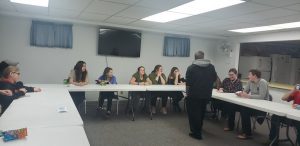 cleaning, or anything really that they need. The ministry, which includes Jake’s wife, Melanie, has helped quite a few people so far. Jake has such a heart for God and trying to bring people to the Lord. In addition to having a heart for God, Jake has a big heart when it comes to his family. He is an amazing dad and husband, and his family is very blessed. Their kids, Alice, Izabella, and Jaxx are a full of fun as their dad…and just as ornery, too. Teasing is a fact of life, and they all love to play and pick on each other. It makes for a funny, noisy household, but that’s part of the fun. Today is Jake’s birthday. Happy birthday Jake!! Have a great day!! We love you!!
cleaning, or anything really that they need. The ministry, which includes Jake’s wife, Melanie, has helped quite a few people so far. Jake has such a heart for God and trying to bring people to the Lord. In addition to having a heart for God, Jake has a big heart when it comes to his family. He is an amazing dad and husband, and his family is very blessed. Their kids, Alice, Izabella, and Jaxx are a full of fun as their dad…and just as ornery, too. Teasing is a fact of life, and they all love to play and pick on each other. It makes for a funny, noisy household, but that’s part of the fun. Today is Jake’s birthday. Happy birthday Jake!! Have a great day!! We love you!!
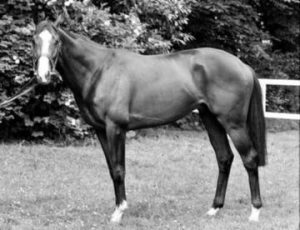 Shergar was a racehorse with the possibility for a great future as a stud horse following his 1981 retirement, but that future was cut short on February 8, 1983, when he was stolen. Shergar was born on March 3, 1978. He was an Irish-bred, British-trained thoroughbred racehorse. Shergar’s owner, The Aga Khan, sent the horse for training in Britain in 1979 and 1980. Shergar began his first season of racing in September 1980 and ran two races that year. He won one and came second in the other. Then, in 1981 he ran in six races, winning five of them. He was an amazing horse. In June that year, he won the 202nd Epsom Derby by ten lengths, which is the longest winning margin in the race’s history. Three weeks later he won the Irish Sweeps Derby by four lengths; a month after that he won the King George VI and Queen Elizabeth Stakes by four lengths. In his final race of the year he came in fourth, and the Aga Khan took the decision to retire him to stud in Ireland. I suppose that like many sports, there is a short window of opportunity with a racehorse, although it seems to me that Shergar had a very short career, but a promising future in stud service to breed racehorses.
Shergar was a racehorse with the possibility for a great future as a stud horse following his 1981 retirement, but that future was cut short on February 8, 1983, when he was stolen. Shergar was born on March 3, 1978. He was an Irish-bred, British-trained thoroughbred racehorse. Shergar’s owner, The Aga Khan, sent the horse for training in Britain in 1979 and 1980. Shergar began his first season of racing in September 1980 and ran two races that year. He won one and came second in the other. Then, in 1981 he ran in six races, winning five of them. He was an amazing horse. In June that year, he won the 202nd Epsom Derby by ten lengths, which is the longest winning margin in the race’s history. Three weeks later he won the Irish Sweeps Derby by four lengths; a month after that he won the King George VI and Queen Elizabeth Stakes by four lengths. In his final race of the year he came in fourth, and the Aga Khan took the decision to retire him to stud in Ireland. I suppose that like many sports, there is a short window of opportunity with a racehorse, although it seems to me that Shergar had a very short career, but a promising future in stud service to breed racehorses.
In 1981 he was retired to what was then the Ballymany Stud in County Kildare, Ireland. Then, in 1983 he was stolen from the stud, and a ransom of £2 million was demanded. The ransom was not paid, and soon the negotiations were broken off by the thieves. In 1999 a confidential informant, formerly in the Provisional Irish Republican Army (IRA), stated that they stole the horse. The IRA has never admitted any role in the theft. After Shergar’s Epsom Derby win, the Aga Khan sold 40 shares in the horse, valuing it at £10 million. Retaining six shares, he created an owners’ syndicate with the remaining 34 members. Shergar was stolen from the Aga Khan’s stud farm by an armed gang on February 8, 1983. Negotiations were conducted with the thieves, but the gang broke off all communication after four days when the syndicate did not accept as truth the proof they provided that the horse was still alive. In 1999 Sean O’Callaghan, a former member of the IRA and probably the confidential informant, published details of the theft and stated that it was an IRA operation to raise money for arms. He said that very soon after the theft, Shergar panicked and damaged his leg, which led to him being killed by the gang. An investigation by The Sunday Telegraph concluded that the horse was shot four days after the theft, or right at the time they stopped negotiations.
Whatever happened to Shergar, there have never been any arrests in the case. Shergar’s body has never been recovered or identified. Some people think it is likely that the body was buried near Aughnasheelin, near Ballinamore, County Leitrim. The Shergar Cup was inaugurated in 1999 in honor of Shergar. His story has been made into movies, several books, and two documentaries. Shergar was a great horse, and should have been allowed to live out his life, but people who only wanted to make money to to buy arms, in an effort to bring mass destruction, couldn’t allow this beautiful horse to live. Anytime a horse is stolen, it is traumatic for the horse. Their schedule is disrupted, they don’t know the people who are taking care of them now, and it is possible that care is not what it should be. The panic that happened to poor Shergar should never have happened. I have no doubt they killed that poor horse, but we will never know for sure.
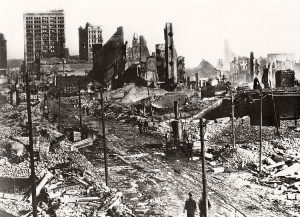 As disastrous fires go, the Great Baltimore Fire comes in historically as the third worst conflagration in an American city, surpassed only by the Great Chicago Fire of 1871, and the San Francisco Earthquake and Fire of 1906. There were other major urban disasters that were comparable in cost, but not fires. These were the Galveston Hurricane of 1900 and most recently, Hurricane Katrina that hit New Orleans and the Gulf of Mexico coast in August 2005.
As disastrous fires go, the Great Baltimore Fire comes in historically as the third worst conflagration in an American city, surpassed only by the Great Chicago Fire of 1871, and the San Francisco Earthquake and Fire of 1906. There were other major urban disasters that were comparable in cost, but not fires. These were the Galveston Hurricane of 1900 and most recently, Hurricane Katrina that hit New Orleans and the Gulf of Mexico coast in August 2005.
On February 7, 1904, a small fire was reported at the John Hurst and Company building on West German Street at Hopkins Place, The site is currently the Royal Farms Arena in the western part of downtown Baltimore. The fire started at about 10:48am, and quickly spread. It wasn’t long before the fire surpassed the ability of the city’s firefighting resources, and calls for help were telegraphed to other cities. By 1:30pm, units from Washington, DC were arriving on the Baltimore and Ohio Railroad at Camden Street Station. Officials decided to use a firebreak in an effort to halt the fires progression. They dynamited buildings around the existing fire. Unfortunately, this tactic was unsuccessful. The fire continued to rage and spread until it was finally brought under control about 5:00pm on February 8, 1904.
In the end, the fire engulfed a large portion of the city that evening. The culprit for starting the fire is believed to have been a discarded cigarette in the basement of the Hurst Building. When the fire was finally out after burning for 31 hours, an 80-block area of downtown Baltimore, stretching from the waterfront to Mount Vernon on Charles Street, had been destroyed. More than 1,500 buildings were completely leveled, and some 1,000 severely damaged, bringing property loss from the disaster to an estimated $100 million. No lives were lose in this disaster…miraculously, although some reports did claim one man died, but that was not confirmed. The fire raged from North Howard Street in the west and southwest, the flames spread north through the retail shopping area as far as Fayette Street and began moving eastward, pushed along by the prevailing winds. Amazingly, it narrowly missed the new 1900 Circuit Courthouse…now known as the Clarence M. Mitchell, Jr. Courthouse. The fire passed the historic Battle Monument Square from 1815 to 1827 at North Calvert Street, and the quarter-century-old 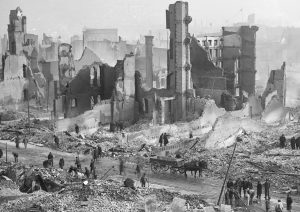 Baltimore City Hall of 1875 on Holliday Street; and finally spread further east to the Jones Falls stream which divided the downtown business district from the old East Baltimore tightly-packed residential neighborhoods of Jonestown…also known as Old Town and newly named Little Italy.” The fire burned as far south as the wharves and piers lining the north side of the old “Basin,” now the “Inner Harbor” of the Northwest Branch of the Baltimore Harbor and Patapsco River facing along Pratt Street. Also spared was Baltimore’s domed City Hall, built in 1867. The Great Baltimore Fire was the most destructive fire in the United States since the Great Chicago Fire of 1871, It destroyed most of the city and caused an estimated $200 million in property damage.
Baltimore City Hall of 1875 on Holliday Street; and finally spread further east to the Jones Falls stream which divided the downtown business district from the old East Baltimore tightly-packed residential neighborhoods of Jonestown…also known as Old Town and newly named Little Italy.” The fire burned as far south as the wharves and piers lining the north side of the old “Basin,” now the “Inner Harbor” of the Northwest Branch of the Baltimore Harbor and Patapsco River facing along Pratt Street. Also spared was Baltimore’s domed City Hall, built in 1867. The Great Baltimore Fire was the most destructive fire in the United States since the Great Chicago Fire of 1871, It destroyed most of the city and caused an estimated $200 million in property damage.

 My niece, Jenny Spethman has gone through many changes in her lifetime…some of them are happy and a few are sad, but Jenny is one of those people who chooses to be happy no matter what her circumstance. It’s a great way to be, although in the really sad times, it can be difficult too. Jenny has been a happy person all her life though, so I think it is a habit. Even as a kid, Jenny filled her life with the happy girly things. That hasn’t changed either. Jenny is very stylish, and she can make an outfit out of a couple of looks that most of us would never think to pair up, but once we see them, we wonder why we couldn’t see it.
My niece, Jenny Spethman has gone through many changes in her lifetime…some of them are happy and a few are sad, but Jenny is one of those people who chooses to be happy no matter what her circumstance. It’s a great way to be, although in the really sad times, it can be difficult too. Jenny has been a happy person all her life though, so I think it is a habit. Even as a kid, Jenny filled her life with the happy girly things. That hasn’t changed either. Jenny is very stylish, and she can make an outfit out of a couple of looks that most of us would never think to pair up, but once we see them, we wonder why we couldn’t see it.
Jenny and her husband, Steve have three sons, Xander, Zack, and Isaac; as well as two daughters, Laila (who lives in Heaven) and Aleesia. The kids are getting older now, and all are in school full time, so about a year and a half ago, Jenny, who had been a stay-at-home mom, decided that she would like to get a part-time job, just to have a little mad money. Jenny had been telling her mom and my sister, Cheryl Masterson for a while that she wanted to get a job. The job of office runner at the legal firm where Cheryl works came up, and Cheryl had been going to mention it to Jenny for a few days, but hadn’t remembered to do it until a week or so later. The morning Cheryl called Jenny, she was literally just getting into her SUV to go look for a job! So, she came in and was hired on the spot…and the rest is history…sort of.
The job was and is perfect for Jenny, because Jenny is a helper, and always has been. She loves to help people, animals, and really every living creature! She doesn’t even step on a spider inside her house. She helps it get outside! Seriously! I would have to draw the line at spiders, so any spiders who don’t want to get squished should probably choose Jenny’s house over mine. Jenny had a specific type of job in mind, and the job of office runner was perfect. She wanted something part-time that would keep her busy and on her feet and moving continually for exercise and to stay in shape. Jenny did expand on the job of office runner in ways that the firm didn’t expect. She has made herself available for whatever anyone needs help doing. An office runner normally just takes documents to the courts or wherever anyone in the office needs work product delivered. They also relieve the front desk receptionist for her break and lunch. That was really all Jenny was required to do, but Jenny changed all that! Her willingness to help, and her desire to keep moving has endeared her to everyone in the office. She has expanded her own job description, without being asked. She is a go-getter, and she also has a listening ear. She listens to the people she works with, and learns their needs and their working style. That makes her a better assistant.
Jenny likes to spread sunshine. She likes to help anyone and everyone have a happy day. She is very sensitive to how people are feeling at any given time. If she senses they need a good word spoken to them, she chooses to be the one who gives it! She brings different thoughts and different ideas to those around her and that makes people like her. The firm really likes Jenny, and has offered her multiple other positions since she started working there, because of her personality and her willingness to work, but she has turned them down. She really likes her current job. The other positions would change everything for her…and for everyone else in the office. While they would like to see her advance, they would hate to lose her in the position she is currently in.
Something Jenny has never changed on is that her family comes first, and for her, the job isn’t about money. It’s about doing a little something extra with her time, and still being there for Steve and their kids. She likes being the runner, the helper! She doesn’t want to sit at a desk all the time, and she knows it! The job is made for her, and so are the hours. She’s truly the best office runner the firm ever had. She does a great job! Jenny brings happiness with her wherever she goes. She is a blessing to everyone who knows her, and in that office, they are grateful to have her. Today is Jenny’s birthday. Happy birthday Jenny!! Have a great day!! We love you!!
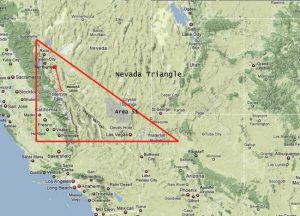
 I think we have all heard of the Bermuda Triangle, where planes and ships have mysteriously gone missing in the Atlantic Ocean for decades, but most people are not aware that there is a similar place in Alaska and one in Nevada. The Nevada Triangle lies in a region of the Sierra Nevada Mountains in Nevada and California. In that area, some 2,000 planes have been lost in the last 60 years. That may not seem significant, but when you break it down, it is about 3 crashes/disappearances a every month of those 60 years. The Nevada Triangle is more than 25,000 miles of mountain desert. It is a remotely populated area, and many of the crash sites have never found.
I think we have all heard of the Bermuda Triangle, where planes and ships have mysteriously gone missing in the Atlantic Ocean for decades, but most people are not aware that there is a similar place in Alaska and one in Nevada. The Nevada Triangle lies in a region of the Sierra Nevada Mountains in Nevada and California. In that area, some 2,000 planes have been lost in the last 60 years. That may not seem significant, but when you break it down, it is about 3 crashes/disappearances a every month of those 60 years. The Nevada Triangle is more than 25,000 miles of mountain desert. It is a remotely populated area, and many of the crash sites have never found.
The triangle location is roughly defined as spanning from Las Vegas, Nevada; to Fresno, California; to Reno, Nevada. Of course, notoriously located in this wilderness area is the mysterious, top-secret Area 51…adding to the mystery of these disappearances. Along with the dozens of conspiracy theories which include UFO’s and paranormal activity that surrounds the air force base, similar theories have long been considered regarding the Nevada Triangle. Throughout these many years, many of the missing planes were flown by experienced pilots and disappeared under mysterious circumstances, with the wreckage never found. I don’t buy into most conspiracy theories, and I don’t know what I think of this situation either, but when you look at the statistics an undeniable picture of strangeness does seem to present itself.
Probably one of the most famous cashes of our current time is that of record-setting aviator, sailor, and adventurer, Steve Fossett on September 3, 2007. Fossett, who was flying a single-engine Bellanca Super Decathlon over Nevada’s Great Basin Desert, took off and never returned. Search crews combed the area for a month, before the search was called off and on February 15, 2008, Fossett was declared dead. Then on September 29th, 2008, Fossett’s identification cards were discovered in the Sierra Nevada Mountains in California by a hiker. Of course, that reactivated the search, and a few days later, the crash site was discovered, located approximately 65 miles from where the aviator initially took off. Initially, no remains were found, but two bones were later recovered a half mile from the crash site which were found to have belonged to Steve Fossett. It is assumed that his body was carried of by wild animals, hence the scattered bones.
One of the earliest incidents of planes lost in the “Triangle” dates back 70 years when a B-24 bomber crashed in the Sierra Nevada mountains in 1943. The bomber, took off on December 5th, piloted by 2nd Lieutenant Willis Turvey and co-piloted by 2nd Lieutenant Robert M Hester. The plane carried four other crew members including 2nd Lieutenant William Thomas Cronin, serving as navigator; 2nd Lieutenant Ellis H Fish, bombardier; Sergeant Robert Bursey, engineer; and Sergeant Howard A Wandtke, radio operator. A routine night training mission, the plane took off from Fresno, California’s Hammer Field destined to Bakersfield, California to Tucson, and then was scheduled to return. The next day an extensive search mission began when nine B-24 Bombers were sent out to find the missing plane. The search was unsuccessful, and also brought about another mystery, when one of the search bombers went missing. On the morning of December 6, 1943, Squadron Commander Captain William Darden lifted off along with eight other B-24s. Captain Darden, his airplane, and remaining crew would not be seen again until 1955, at which point the Huntington Lake reservoir was drained for repairs to the dam. I suppose that all of the missing planes are somewhere, and might still be discovered someday, bit it is a vast area, and it is almost impossible to search all of it. Even with information concerning Captain Darden and his B-24, by survivors who bailed out at the captains orders, that the captain tried to land in a clearing that ended up being a half frozen lake, it still took twelve years to locate the plane.
The father of the original B-24’s co-pilot never gave up the search, although he was unsuccessful and died of a heart attack in 1959, about 14 years after the crash. One year after Clinton Hester passed away, the wreckage was found in July 1960 by to United States Geological Survey researchers who were working in a remote section of the High Sierra, west of LeConte Canyon in Sequoia and Kings Canyon National Parks. There, they found airplane wreckage in and near an unnamed lake. Later, Army investigators revealed the wreckage to be that of the first missing bomber piloted by 2nd Lieutenant Willis Turvey and co-piloted by 2nd Lieutenant Robert M. Hester. The lake is now known as Hester Lake.
It would seem that the Kings Canyon National Park area is a tough one to search, and seems to hold the key to may of the missing planes. As odd as some of these events sound, I find it hard to believe that they could have just disappeared. Still, I’m no expert in the matter, and these may not have been the only time something or someone just went missing. I am reminded of Enoch in the Bible, “And Enoch walked with God and disappeared because God took him.” Genesis 5:24. Whatever may have happened in these cases of missing planes, some of which we may never know, and some that may remain a mystery for years; the fact remains that this is a very difficult area to search, and so we really just don’t know. “Conspiracy theorists have long claimed the reason so many flights have disappeared is connected to the presence Area 51, where the US Air Force is known to test secret prototype aircraft. But, many experts believe the disappearances can be attributed to the areas geography and atmospheric conditions. The Sierra Nevada mountains run perpendicular to the Jet Stream, or high Pacific winds, which conspire with the sheer, high altitude peaks and wedge-shaped range to create volatile, unpredictable winds and downdrafts. This weather phenomenon is sometimes called the “Mountain 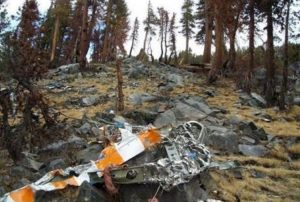
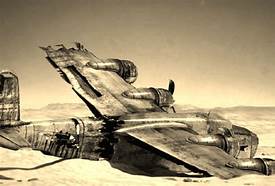 Wave” where planes are seemingly ripped from the air and crashed to the ground.” Of course, many experts believe they are pilot error, inexperienced pilots getting caught in turbulence, and the disorienting mountain terrain. I suppose that is possible, but that is a lot of cases over the past 60 years. Then again, not every plane that flies over the area disappears either, so who am I to say.
Wave” where planes are seemingly ripped from the air and crashed to the ground.” Of course, many experts believe they are pilot error, inexperienced pilots getting caught in turbulence, and the disorienting mountain terrain. I suppose that is possible, but that is a lot of cases over the past 60 years. Then again, not every plane that flies over the area disappears either, so who am I to say.
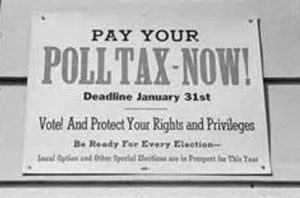 Those of us living today, might not have heard of a thing called a Poll Tax, but it was a very real thing, and with the election process just behind us, I think this might be something worth hearing. The Poll Tax was also known as a head tax or a capitation tax (meaning a tax for a head count). When I first thought about this particular tax, I thought well, maybe that kind of a tax could have ensured a fair election, but really, the opposite is true. While the head tax was considered an important source of revenue for many governments, from ancient times until the 19th century, in the United States at least; voting poll taxes (whose payment was a precondition to voting in an election) have been used to disenfranchise impoverished and minority voters (especially under Reconstruction). I find that absolutely unbelievable. In this nation in most election years, we have to practically beg people to get out and vote. Charging them money for it would all but insure a poor turnout. It would also insure that only those well enough off to be able to “throw money” at an election would be able to vote. Now that is truly appalling.
Those of us living today, might not have heard of a thing called a Poll Tax, but it was a very real thing, and with the election process just behind us, I think this might be something worth hearing. The Poll Tax was also known as a head tax or a capitation tax (meaning a tax for a head count). When I first thought about this particular tax, I thought well, maybe that kind of a tax could have ensured a fair election, but really, the opposite is true. While the head tax was considered an important source of revenue for many governments, from ancient times until the 19th century, in the United States at least; voting poll taxes (whose payment was a precondition to voting in an election) have been used to disenfranchise impoverished and minority voters (especially under Reconstruction). I find that absolutely unbelievable. In this nation in most election years, we have to practically beg people to get out and vote. Charging them money for it would all but insure a poor turnout. It would also insure that only those well enough off to be able to “throw money” at an election would be able to vote. Now that is truly appalling.
It is my understanding that originally the “poll tax” or maybe more correctly, head tax was not about an election, but more like the census. It even has Biblical roots…Mary and Joseph went to Bethlehem to be counted and pay their taxes to Caesar Augustus. This was the first of the head taxes. The tax might have been originally a way to bring in revenue. The poll taxes that followed, in most cases, were purely discriminatory. 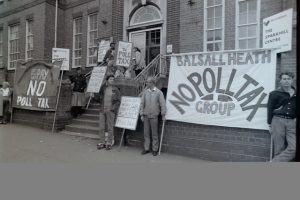 These latter poll taxes ensured that only wealthy people got the chance to cast their vote…thereby putting in candidates that those in charge wanted.
These latter poll taxes ensured that only wealthy people got the chance to cast their vote…thereby putting in candidates that those in charge wanted.
While the Poll Tax might have been a way to bring in money for governments, it seems to me that it could also be a way to make sure that the people vote for the candidate the government wants. Those who might have voted for change to improve the situation in their own neighborhoods, towns, cities, and states, were usually the poorer people, but they couldn’t vote for someone who could help, because they didn’t have the money. Many of these people were minorities. Head taxes were important sources of revenue for many governments from ancient times until the 19th century. In the United Kingdom, poll taxes were levied by the governments of John of Gaunt in the 14th century, Charles II in the 17th and Margaret Thatcher in the 20th century. By their very nature, poll taxes are considered very regressive taxes, are usually very unpopular and have been implicated in many uprisings.
On August 27, 1962, the Twenty-fourth Amendment (Amendment XXIV) of the United States Constitution was proposed. The Twenty-fourth Amendment prohibits both Congress and the states from conditioning the right to vote in federal elections on payment of a poll tax or other types of tax. The amendment was ratified by the states on January 23, 1964. When the 24th Amendment was ratified in 1964, five states still retained a poll tax. Those states were Alabama, Arkansas, Mississippi, Texas, and Virginia. These states continues the practice  even though the amendment prohibited requiring a poll tax for voters in federal elections. Finally, in 1966 the US Supreme Court ruled 6–3 in Harper v. Virginia Board of Elections, that poll taxes for any level of elections were unconstitutional. The ruling stated that the poll tax violated the Equal Protection Clause of the Fourteenth Amendment. Further litigation related to potential discriminatory effects of voter registration requirements has generally been based on application of this clause. Those of us living today, might not have heard of a thing called a Poll Tax, but it was a very real thing, and with the election process just behind us, I think this might be something worth hearing. The Poll Tax was also known as a head tax or a capitation tax (meaning a tax for a head count).
even though the amendment prohibited requiring a poll tax for voters in federal elections. Finally, in 1966 the US Supreme Court ruled 6–3 in Harper v. Virginia Board of Elections, that poll taxes for any level of elections were unconstitutional. The ruling stated that the poll tax violated the Equal Protection Clause of the Fourteenth Amendment. Further litigation related to potential discriminatory effects of voter registration requirements has generally been based on application of this clause. Those of us living today, might not have heard of a thing called a Poll Tax, but it was a very real thing, and with the election process just behind us, I think this might be something worth hearing. The Poll Tax was also known as a head tax or a capitation tax (meaning a tax for a head count).

 My nephew, Dave Chase has been such a blessing to our family since he married my niece, Toni. Dave always goes above and beyond just being Toni’s husband. Dave treats Toni like a queen. She feels his love in everything he said says, and that is a beautiful kind of love to have. Dave is devoted to his family. He and Toni’s son, James are good friends, and Dave never tries to take the place of James’ dad, but he is always there for him too. As a family, they have taken many trips, and seen many places. Dave likes to travel, and so do Toni and James, so it works out well for all. Of course, 2020 was…very different, for all of us.
My nephew, Dave Chase has been such a blessing to our family since he married my niece, Toni. Dave always goes above and beyond just being Toni’s husband. Dave treats Toni like a queen. She feels his love in everything he said says, and that is a beautiful kind of love to have. Dave is devoted to his family. He and Toni’s son, James are good friends, and Dave never tries to take the place of James’ dad, but he is always there for him too. As a family, they have taken many trips, and seen many places. Dave likes to travel, and so do Toni and James, so it works out well for all. Of course, 2020 was…very different, for all of us.
With Covid-19, everyone spent most of the year doing a new activity…social distancing. It is a phrase we have all learned to hate. We were stuck at home, not travel, no restaurants, no movies, even no camping…in the woods, away from people, for Pete’s sake. Some of that is behinds us now, or at least for now, but during the year, it was pretty awful. For the average person the problems were truly annoying, but for lots of people the problems were much worse. One of the biggest problems was depression. But other serious problems include loneliness, fear, and helplessness.
All that is the norm for the Covid-19 Lockdowns, but not if you’re Dave Chase. I would have expected Dave to be going stir-crazy…especially since Dave, Toni, and James did not catch Covid-19. Dave is very sports oriented. He always has been, but he did not let the lack of sports, gyms, and any other form of activities get him down. Dave just shifted gears and embraced the lockdowns by learning how to do indoor golf, online fantasy football, baseball, golf, and college basketball. Lots of guys go in for that, but I don’t think it would be for me. Once people could go outside much, Dave was out there fishing, and having good success at it too. As things finally started opening up, at least in Wyoming, Dave has been able to go back to playing live basketball, 
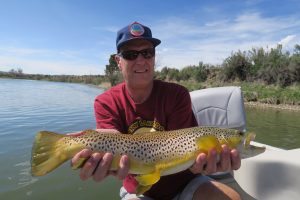 recently. You might think that after not playing for a long time, Dave might be a bit rusty, but not so. He is still the champ, even among his 30-year younger teammates. Dave has also enjoyed being able to have friends come over, like his buddy, Ron Birks. So, even with the Covid-19 Lockdown, Dave has stayed pretty sane. Not bad!! Not bad at all!! Today is Dave’s birthday. Happy birthday Dave!! Have a great day!! We love you!!
recently. You might think that after not playing for a long time, Dave might be a bit rusty, but not so. He is still the champ, even among his 30-year younger teammates. Dave has also enjoyed being able to have friends come over, like his buddy, Ron Birks. So, even with the Covid-19 Lockdown, Dave has stayed pretty sane. Not bad!! Not bad at all!! Today is Dave’s birthday. Happy birthday Dave!! Have a great day!! We love you!!
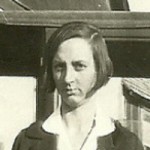
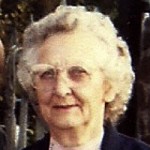 My husband’s grandmother, Vina Hein was an amazing woman. We always loved going up to visit her and Grandpa Hein. They lived on a ranch outside of Forsyth, Montana, and that place will forever live in my memory files. I can see every part of the house and the different things we did there. I remember all the nights of playing cards. We always played “Spades” and Grandma always had a funny saying when she looked at her hand and it wasn’t a good one. She would tell us that she had “a hand like a foot!!” We often looked through all the old photo albums too. Those pictures are great treasures, and I feel privileged to have been able to look through them. They were pure family history. Going to see Grandma and Grandpa Hein was such a blessing, and one I will always cherish.
My husband’s grandmother, Vina Hein was an amazing woman. We always loved going up to visit her and Grandpa Hein. They lived on a ranch outside of Forsyth, Montana, and that place will forever live in my memory files. I can see every part of the house and the different things we did there. I remember all the nights of playing cards. We always played “Spades” and Grandma always had a funny saying when she looked at her hand and it wasn’t a good one. She would tell us that she had “a hand like a foot!!” We often looked through all the old photo albums too. Those pictures are great treasures, and I feel privileged to have been able to look through them. They were pure family history. Going to see Grandma and Grandpa Hein was such a blessing, and one I will always cherish.
Grandma Hein was born on Groundhog’s Day, a fact that she enjoyed very much. It seems that finding out if spring would come early each year was something special. Of course, the biggest problem with that is that all too often Punxsutawney Phil was, and still is, very wrong. I have given up on that silly ground hog!! Even with this morning’s prediction that we will have 6 more weeks of Winter, it would be just a coincidence if that is the way it went, because that silly ground hog gets it wrong 99% of the time. Still, for Grandma, it was cool to have that birthday. I guess that when you think about it, at least you were on the downhill side of the Winter, so spring was coming.
I think Grandma was like me, in that Winter was her least favorite season. Living in the country is more work anyway, and the Winter weather makes it worse. Montana winters are notoriously bitter, so I can see why she would rather have any other season. Grandma wasn’t one to have lots of flowers in the house, that I recall, but 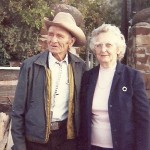
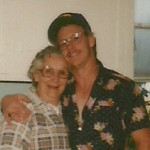 that didn’t mean she couldn’t grow a garden, because she certainly could. She canned vegetables and made jellies and apple butter. She also made wonderful strawberry-rhubarb pie. there was also always plant of fresh real cream on her table from the cows they milked. You haven’t tasted cream, until you have had it fresh, without all the processing. Oh my!! It is so good. I will never forget the trips we took to see Grandma and Grandpa Hein. I will always have those cherished memories. Today would have been Grandma Hein’s 112th birthday. Happy birthday in Heaven Grandma Hein. We love and miss you very much.
that didn’t mean she couldn’t grow a garden, because she certainly could. She canned vegetables and made jellies and apple butter. She also made wonderful strawberry-rhubarb pie. there was also always plant of fresh real cream on her table from the cows they milked. You haven’t tasted cream, until you have had it fresh, without all the processing. Oh my!! It is so good. I will never forget the trips we took to see Grandma and Grandpa Hein. I will always have those cherished memories. Today would have been Grandma Hein’s 112th birthday. Happy birthday in Heaven Grandma Hein. We love and miss you very much.

